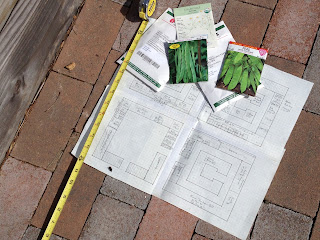Spring Planting Update: Potatoes and Peas
This past weekend was so lovely — sunny and (for March in New England) warm. Nothing at all like today, where we're struggling to stay at 40 degrees, and with a gusty windchill that's back into the 30s. We're also going to have lows in the 20s tonight, all of which sets back my hardening off schedule for the cabbage and broccoli seedlings that should be planted next weekend.
So let's look back on a nice day instead of thinking about this cold one, shall we?
After adding compost to the beds we needed, we were ready to go with three varieties of peas (Premium Nat, Penelope, and Sugar Snap). The tape measure was to keep us on track to plant them every six inches; the garden plan to remind us where we want to put them. Loving the smaller-scale garden plan this year — much more convenient.
Once we got the trellises up (Kirk had to build some more, by the way, since the rose trellis-turned-pea brush schemes last year didn't work out too well), I set out a double row of peas (one row on either side of the trellis netting) every three inches along the tape measure. Tiegan came along behind me and poked them into the ground, then used a watering can to give them all a good soaking. It was a good, efficient system — which is important when you need to plant out 73 row feet of peas!
Kirk also built six new potato boxes to replace our half-assed ones from last year. The old ones didn't seem bad at first, but we didn't make them so that the height of the walls could gradually be increased as the plant grew, so it wasn't very effective. The new design is based on one I found on Pinterest. Our boxes are two square feet, and about 30-36 inches tall. There are four seed potatoes in each: Half are Kennebec, and half are Red Pontiac.
The idea here is that once the potato leaves get to be about a foot tall, we'll add another six-inch board all around the sides, working our way up to the top. Like their relatives the tomatoes, potato plants will form more roots (and potatoes!) along their stems if the stems are covered in dirt. So continually boxing up the stems (a super-intensive take on traditional hilling methods) should lead to increased yields. I hope so, because we haven't had potatoes in months!
In addition to laying out these big staple crops, I also sowed some chamomile seeds in a cold frame. These don't need the protection of a cold frame to grow, but there just happens to be a cold frame leftover from the winter where I want the chamomile to be. So this year, they get an extra-cushy start.
Lots of good, clean/dirty weekend work!






Comments
Post a Comment